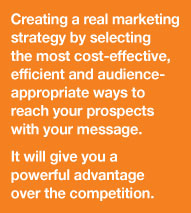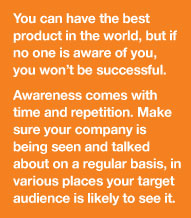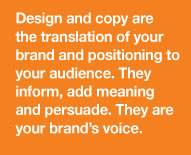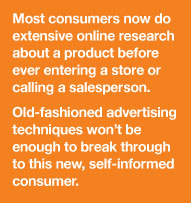If you’ve decided it’s time to come up with a marketing strategy or plan that will grow your business, this article will help you get started.
Your marketing strategy is the way you’ll promote your products or services to the public, but not simply by running an ad. Creating a real strategy involves selecting the most cost-effective, efficient and audience-appropriate ways to reach your target prospects with your USP. It will give you a powerful advantage over the competition.
 Tactics are the elements you will use to execute your strategy. They can include: direct mail, print ads, PR, sales training, promotions, event sponsorships, holding seminars, email marketing, blogging, etc. You’ll use a combination of tactics to get your message out there and get your prospects to take the action you want such as; call, email, visit a store, download a brochure. Using more than one tactic to reach your audience is called Multi-Channel Marketing. Be sure to think of your audience when choosing tactics. Are they heavy computer users, radio listeners, commuters who pass billboards, coupon cutters, magazine readers? Use their habits to determine your tactics.
Tactics are the elements you will use to execute your strategy. They can include: direct mail, print ads, PR, sales training, promotions, event sponsorships, holding seminars, email marketing, blogging, etc. You’ll use a combination of tactics to get your message out there and get your prospects to take the action you want such as; call, email, visit a store, download a brochure. Using more than one tactic to reach your audience is called Multi-Channel Marketing. Be sure to think of your audience when choosing tactics. Are they heavy computer users, radio listeners, commuters who pass billboards, coupon cutters, magazine readers? Use their habits to determine your tactics.
12 Great Tips for Creating Your Strategy and Targeting Prospects
The two most important factors for small to medium size businesses to focus on are awareness and relevant differentiation (USP). Either one alone is ineffective; together they can be a powerhouse. These tips will help you create a strategy to achieve just that.
 1. You can have the best product or service in the world, but if no one is aware of you, you won’t be successful.
1. You can have the best product or service in the world, but if no one is aware of you, you won’t be successful.
You can build awareness in a variety of ways: advertising, PR, newsletters, signage, direct mail, product samples. But, have you thought about producing a webinar, writing an article, sponsoring an event, branding your vehicle (a traveling billboard) or co-marketing with a complementary product? Be on the lookout for great promotional ideas and strategies used by other industries and see if you can adapt them to your advantage. Awareness comes with time and repetition, so the important thing is to keep at it. Make sure your company is being seen and talked about on a regular basis, in various places your target audience is likely to see it.
2. Once people are aware of your product, why should they choose it over all the others?
Awareness is great but it isn’t a magic bullet. People choose products that stand out in relevant and compelling ways. Your USP should be based on your knowledge of your prospects, their needs, problems, anxieties and expectations. Then you fill those needs, alleviate those anxieties and exceed those expectations. Try thinking like a customer. Jerold Panas said it well in his book Making the Case “People don’t go to a hardware store to buy a drill. They go to a hardware store to buy a drill because they need a hole.”
The key to a good USP is having a clear message that highlights your unique strengths and explains to prospects why your product is the best choice. You’ll find it more effective to tell them how your product or service solves their problem rather than just listing its features. Keep their perspective in mind, not yours. If you have a case study of how your product has solved the problems of others, even better! That can give you the credibility you need to make the sale.
3. How, exactly, do you get your message to the audience?
You’ll need to gain some knowledge about your prospects in order to reach them. You need to find out:
• Who the real decision-makers are (there may be more than one)
• What or who influences this target audience’s opinions
• What motivates him or her (speed, price, ego, style…)
• Where he or she gets information about your product category (trade magazines, internet sites, conferences…)
• The type of message they are likely to respond to: product samples, coupons, free evaluations, etc.
Use this knowledge to get the right message to prospects as efficiently as possible through the channels they use to gather information.
One way to determine all these facts is to hold an informal focus group with some of your current customers. This could be done by a phone, mail or email survey, or even by taking a select group of customers out to lunch, independently or as a group, to discuss these issues. Ask them where they get their information. For example, how did your prospects find out about some of the other products or services that they purchased recently? What web sites do they turn to for information? What keywords do they use to search for your type of product? (You’ll learn the importance of these keywords later). What trade associations do they belong to? What trade shows do they attend? What publications do they read regularly? You can rent these publications’ mailing lists, advertise on these web sites and visit or exhibit at these trade shows. This process of getting to know more about your existing clients will help you decide what methods to use to reach others like them. Don’t fall into the trap of assuming you know the answers if you haven’t actually asked your customers – they may surprise you.
4. Perform your own analysis of the competition.
It’s always a good idea to keep an eye on the competition. Start by reading local newspapers, trade journals, industry newsletters and visit web sites in your category to request information. Check who comes up in the top 30 results for Google® searches your potential clients are likely to use. You can learn a lot about your competition through their own advertising and PR. The idea here is not to copy them, but to know what you are up against.
5. Say it loud and say it often: multi-touch.
Once you know who you are selling to and what methods or tactics you will use to reach them, you’ll need to contact them at regular intervals using several channels (tactics). Frequency of contact (multi-touch) is important simply because people forget. It takes an average of 7-9 impressions to make an impact. Even when you have piqued their interest, if they don’t act immediately they will forget you in a week or two. Also, remember your prospects’ lives are constantly changing and their needs change unexpectedly. Just because they didn’t need your product or service two months ago doesn’t mean they don’t need it now. A multi-touch approach will build the brand awareness you need.
6. Say it here, say it there: multi-channel.
Be sure to use more than one method of contact or “channel” for your marketing. Your prospects are bound to have different preferences in how they like to receive information: email, print ads, direct mail, etc. Multiple channels allow you to communicate more often. The more often you interact with your prospect and the more relevant the information you provide, the more effective your campaign will be at rising above the clutter.
All of these communications need to make an offer and give your prospects a clear Call-to-Action. It doesn’t hurt to state it again and maybe again. It may sound obvious but be sure to tell them what you want them to do: call, order, visit a store, attend a webinar, doing so will raise your success rate.
Measure, refine and optimize your marketing channel mix. Spend wisely and calculate your cost per generated lead in each channel. Then stick with the most successful ones that produce the highest ROI. Implementing a good campaign will not only help your message reach the client at the correct time, but also extend the reach and improve the effectiveness of your sales force.
7. Anticipate objections.
Ask your salespeople (or yourself) what your prospect’s main objection to buying usually is – cost, fear of change, reliability – and address it up-front in your marketing. Then direct them to where they can find more information, request a brochure, visit your web site, etc. Many people won’t call a sales rep or visit a store early in the decision making process because they’re afraid of getting a hard sell. Give them a painless way to learn more.
8. Sometimes less is more.
No matter which channel you’re using, don’t overwhelm your prospect with too much information at once. Company history and mission statements can wait. Tell the prospect what problem your product or service will solve for them, what benefit they will derive, and use your USP to make you the obvious choice for them to make.
If you have several benefits to extol, try different campaigns emphasizing one benefit in each. You can still use the text of the piece to mention the additional benefits, but if you give equal emphasis to everything, nothing will stand out. Test to see what benefit gets a response from what target audience. Then you can target more effectively. Always ask the prospect for an action or response. You want them to call, mail or visit your web site to sign up for a newsletter or class, download a white paper, get more information or order your product. In any case, you now have a true sales lead to follow up on.
9. Make it easy for an interested prospect to contact you.
Always consistently display your brand’s logo, tagline, contact information and web site address at all customer touchpoints, from letterhead, business cards and emails to company vehicles, signage, ads, etc. Provide several ways to respond to your offer – call, visit our web site, mail a response card, let them choose what they prefer.
 10. Details matter! Professional design & copy writing enhance your strategy.
10. Details matter! Professional design & copy writing enhance your strategy.
It takes more than strategy to build a brand. You’ll need the right words and visuals as well. After putting all this thought and effort into your brand, strategy and marketing tactics, don’t fall into the trap of skimping on the execution. Design and copy are the translation of your brand and positioning to your audience. When done well they add meaning, they inform and persuade. They can engage the reader and evoke an emotional response. They are your brands voice. Poor design, copywriting and printing make you look like a fly-by-night operation they may want to stay clear of. Not the emotional response you intended.
Understanding and managing the creative process will give you a distinct advantage over the competition. Use it to achieve maximum brand-building results with each project. In order to get the most out of your designers and copywriters you need to involve them as early on in the process as possible. They have the experience to craft your message visually and verbally for maximum effect. If design is applied at the end of a project as an afterthought it will only serve as decoration that won’t add to the effectiveness of the piece. Design can be used to overcome communication problems, positioning problems, change perceptions and add differentiation if you make it an integral part of your strategy. Professional copywriting will give clarity and add interest to your message. It will help prospects identify with your brand and its message.
Both professional design and copywriting add value by providing distinctive content and credibility. Consider them a good investment of marketing dollars. These are strategic advantages – a way to stand out from all the other communications that are bombarding your prospects each day. It directly contributes to the bottom line.
Every marketing piece potential customers come in contact with must look professional and worthy of their time to view it. Having a professional appearance in all your marketing efforts will instill confidence and reinforce your brand’s reputation while giving you the most mileage out of every marketing dollar you spend.
Consistency is key. You will want to convey a consistent message, tone and visual look in all of your projects. Tying all these disparate materials together with design and a common voice creates brand harmony. This will turn your USP into a compelling visual as well as verbal message.
If all these task seems too daunting or expensive, redesign and rewrite the pieces one at a time, as time and budgets allow. But don’t miss out on this important aspect in implementing your new marketing strategy.
11. Performing a brand harmony audit–not as painful as it sounds.
There is an easy way to determine how consistent your current marketing materials are: perform an audit. Gather together all the materials your company puts in front of customers on one table. Find all the brochures, ads, direct mail pieces, catalogs, signage, web site, packaging, trade show exhibits, etc, (take photos or use printouts where necessary). Start sorting them by visual style. Is your company’s brand and USP coming through? Does one item relate to the next, or do they look completely different? Is the quality of the printed pieces up to your standards? Start reading the headlines and copy. Does the copy have the same tone or “voice” from piece to piece? You may find that some pieces are working well together, but maybe the signage or web site needs to be brought in line. Or, you may find a huge kaleidoscope of design styles and copy tones. In either case, you now know if you are using design, photography, copywriting and printing to their fullest potential and you can start producing materials that are based on your strategy.
Now that you are in auditing mode, why not take it a step further and compare your materials to the competition’s? Collect sales and marketing materials from your rivals and examine their web sites. It’s always a good idea to get on their direct mail and email lists. Do their materials look and sound alike? Are they all making the same claims? Don’t duplicate them, be different and beat their offer or benefit. Appeal to a niche not being well served or solve a problem they aren’t addressing. This is where your USP comes in. Use it to stand out from this crowd.
 Getting it done.
Getting it done.
Sales is a process of communication, not a one-time event. You’ve got to stay in front of your prospects through repeated contacts – whether that’s direct mail, sales calls, online press releases or, more likely, a combination of several tactics. That’s the essence of multi-channel, multi-touch marketing. Not just any contact will do. You need meaningful, informative, educational, persuasive contacts that address the issues and concerns of your prospects through your USP.
Smaller or newer businesses on tight budgets can approach these goals in stages as time and money allow. Start with your USP to set yourself apart. Define your goals, determine some tactics to achieve them, then start with your next marketing piece or activity. Take every opportunity to align your efforts with the new strategy until all your marketing efforts have brand harmony.
Regardless of whether you sell B2B or B2C, marketers are finding out that it’s all about people. Tap into your target audience as a person, not just a title or statistic. If you connect with them emotionally, by solving their problems and addressing their concerns, you’ll succeed.






